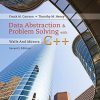Single Variable Calculus Early Transcendentals 7th Edition by James Stewart ISBN 1133419577 9781133419570
$70.00 Original price was: $70.00.$35.00Current price is: $35.00.
Instant download Single Variable Calculus. Early Transcendentals 7th Edition after payment
Single Variable Calculus Early Transcendentals 7th Edition by James Stewart – Ebook PDF Instant Download/Delivery: 1133419577, 9781133419570
Full download Single Variable Calculus Early Transcendentals 7th edition after payment

Product details:
ISBN 10: 1133419577
ISBN 13: 9781133419570
Author: James Stewart
James Stewart’s CALCULUS: EARLY TRANSCENDENTALS texts are widely renowned for their mathematical precision and accuracy, clarity of exposition, and outstanding examples and problem sets. Millions of students worldwide have explored calculus through Stewart’s trademark style, while instructors have turned to his approach time and time again. In the Seventh Edition of SINGLE VARIABLE CALCULUS: EARLY TRANSCENDENTALS, Stewart continues to set the standard for the course while adding carefully revised content. The patient explanations, superb exercises, focus on problem solving, and carefully graded problem sets that have made Stewart’s texts best-sellers continue to provide a strong foundation for the Seventh Edition. From the most unprepared student to the most mathematically gifted, Stewart’s writing and presentation serve to enhance understanding and build confidence. CourseSmart goes beyond traditional expectations providing instant, online access to the textbooks and course materials you need and at a lower cost to your students. To request an electronic sample of this Cengage Learning title, go to: www.coursesmart.com/instructors.
Single Variable Calculus Early Transcendentals 7th Table of contents:
Chapter 1: Functions and Models
1.1: Four Ways to Represent a Function
1.2: Mathematical Models: A Catalog of Essential Functions
1.3: New Functions from Old Functions
1.4: Graphing Calculators and Computers
1.5: Exponential Functions
1.6: Inverse Functions and Logarithms
1 Review
Principles of Problem Solving
Chapter 2: Limits and Derivatives
2.1: The Tangent and Velocity Problems
2.2: The Limit of a Function
2.3: Calculating Limits Using the Limit Laws
2.4: The Precise Definition of a Limit
2.5: Continuity
2.6: Limits at Infinity; Horizontal Asymptotes
2.7: Derivatives and Rates of Change
2.8: The Derivative as a Function
2 Review
Problems Plus
Chapter 3: Differentiation Rules
3.1: Derivatives of Polynomials and Exponential Functions
3.2: The Product and Quotient Rules
3.3: Derivatives of Trigonometric Functions
3.4: The Chain Rule
3.5: Implicit Differentiation
3.6: Derivatives of Logarithmic Functions
3.7: Rates of Change in the Natural and Social Sciences
3.8: Exponential Growth and Decay
3.9: Related Rates
3.10: Linear Approximations and Differentials
3.11: Hyperbolic Functions
3 Review
Problems Plus
Chapter 4: Applications of Differentiation
4.1: Maximum and Minimum Values
4.2: The Mean Value Theorem
4.3: How Derivatives Affect the Shape of a Graph
4.4: Indeterminate Forms and l’Hospital’s Rule
4.5: Summary of Curve Sketching
4.6: Graphing with Calculus and Calculators
4.7: Optimization Problems
4.8: Newton’s Method
4.9: Antiderivatives
4 Review
Problems Plus
Chapter 5: Integrals
5.1: Areas and Distances
5.2: The Definite Integral
5.3: The Fundamental Theorem of Calculus
5.4: Indefinite Integrals and the Net Change Theorem
5.5: The Substitution Rule
5 Review
Problems Plus
Chapter 6: Applications of Integration
6.1: Areas Between Curves
6.2: Volumes
6.3: Volumes by Cylindrical Shells
6.4: Work
6.5: Average Value of a Function
6 Review
Problems Plus
Chapter 7: Techniques of Integration
7.1: Integration by Parts
7.2: Trigonometric Integrals
7.3: Trigonometric Substitution
7.4: Integration of Rational Functions by Partial Fractions
7.5: Strategy for Integration
7.6: Integration Using Tables and Computer Algebra Systems
7.7: Approximate Integration
7.8: Improper Integrals
7 Review
Problems Plus
Chapter 8: Further Applications of Integration
8.1: Arc Length
8.2: Area of a Surface of Revolution
8.3: Applications to Physics and Engineering
8.4: Applications to Economics and Biology
8.5: Probability
8 Review
Problems Plus
Chapter 9: Differential Equations
9.1: Modeling with Differential Equations
9.2: Direction Fields and Euler’s Method
9.3: Separable Equations
9.4: Models for Population Growth
9.5: Linear Equations
9.6: Predator-Prey Systems
9 Review
Problems Plus
Chapter 10: Parametric Equations and Polar Coordinates
10.1: Curves Defined by Parametric Equations
10.2: Calculus with Parametric Curves
10.3: Polar Coordinates
10.4: Areas and Lengths in Polar Coordinates
10.5: Conic Sections
10.6: Conic Sections in Polar Coordinates
10 Review
Problems Plus
Chapter 11: Infinite Sequences and Series
11.1: Sequences
11.2: Series
11.3: The Integral Test and Estimates of Sums
11.4: The Comparison Tests
11.5: Alternating Series
11.6: Absolute Convergence and the Ratio and Root Tests
11.7: Strategy for Testing Series
11.8: Power Series
11.9: Representations of Functions as Power Series
11.10: Taylor and Maclaurin Series
11.11: Applications of Taylor Polynomials
11 Review
Problems Plus
Appendixes
Appendix A: Numbers, Inequalities, and Absolute Values
Appendix B: Coordinate Geometry and Lines
Appendix C: Graphs of Second-Degree Equations
Appendix D: Trigonometry
Appendix E: Sigma Notation
Appendix F: Proofs of Theorems
Appendix G: The Logarithm Defined as an Integral
Appendix H: Complex Numbers
Appendix I: Answers to Odd-Numbered Exercises
Index
People also search for Single Variable Calculus Early Transcendentals 7th :
single variable calculus early transcendentals 7th edition
single variable calculus early transcendentals 7th edition answers
single variable calculus early transcendentals answers
single variable calculus early transcendentals 7th edition by james stewart
single variable calculus early transcendentals quizlet
Tags: James Stewart, Single Variable, Early Transcendentals


